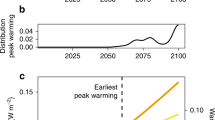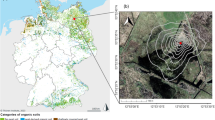Abstract
Water-table drawdown across peatlands increases carbon dioxide (CO2) and reduces methane (CH4) emissions. The net climatic effect remains unclear. Based on global observations from 130 sites, we found a positive (warming) net climate effect of water-table drawdown. Using a machine-learning-based upscaling approach, we predict that peatland water-table drawdown driven by climate drying and human activities will increase CO2 emissions by 1.13 (95% interval: 0.88–1.50) Gt yr−1 and reduce CH4 by 0.26 (0.14–0.52) GtCO2-eq yr−1, resulting in a net increase of greenhouse gas of 0.86 (0.36–1.36) GtCO2-eq yr−1 by the end of the twenty-first century under the RCP8.5 climate scenario. This drops to 0.73 (0.2–1.2) GtCO2-eq yr−1 under RCP2.6. Our results point to an urgent need to preserve pristine and rehabilitate drained peatlands to decelerate the positive feedback among water-table drawdown, increased greenhouse gas emissions and climate warming.
This is a preview of subscription content, access via your institution
Access options
Access Nature and 54 other Nature Portfolio journals
Get Nature+, our best-value online-access subscription
$29.99 / 30 days
cancel any time
Subscribe to this journal
Receive 12 print issues and online access
$209.00 per year
only $17.42 per issue
Buy this article
- Purchase on Springer Link
- Instant access to full article PDF
Prices may be subject to local taxes which are calculated during checkout



Similar content being viewed by others
Data availability
Source datasets and global maps generated in this study are available at https://doi.org/10.6084/m9.figshare.13139906.v342.
Code availability
Calculations were conducted through Python 3.7.3, R 3.6.2 and ferret 6.72. Data processing code and code used to generate figures are provided through https://doi.org/10.6084/m9.figshare.13139906.v342.
References
Yu, Z. C., Loisel, J., Brosseau, D. P., Beilman, D. W. & Hunt, S. J. Global peatland dynamics since the Last Glacial Maximum. Geophys. Res. Lett. https://doi.org/10.1029/2010gl043584 (2010).
Frolking, S. et al. Peatlands in the Earth’s 21st century climate system. Environ. Rev. 19, 371–396 (2011).
Myhre, G. et al. Anthropogenic and Natural Radiative Forcing (Cambridge Univ. Press, 2013).
Ise, T., Dunn, A. L., Wofsy, S. C. & Moorcroft, P. R. High sensitivity of peat decomposition to climate change through water-table feedback. Nat. Geosci. 1, 763–766 (2008).
Leifeld, J. & Menichetti, L. The underappreciated potential of peatlands in global climate change mitigation strategies. Nat. Commun. 9, 1071 (2018).
Hooijer, A. et al. Subsidence and carbon loss in drained tropical peatlands. Biogeosciences 9, 1053–1071 (2012).
Nagano, T. et al. Subsidence and soil CO2 efflux in tropical peatland in southern Thailand under various water table and management conditions. Mires Peat 11, 6 (2013).
Erkens, G., van der Meulen, M. J. & Middelkoop, H. Double trouble: subsidence and CO2 respiration due to 1,000 years of Dutch coastal peatlands cultivation. Hydrol. J. 24, 551–568 (2016).
Swindles, G. T. et al. Widespread drying of European peatlands in recent centuries. Nat. Geosci. 12, 922–928 (2019).
2013 Supplement to the 2006 IPCC Guidelines for National Greenhouse Gas Inventories: Wetlands (eds Hiraishi, T. et al.) (IPCC, 2014).
Wilson, D. et al. Greenhouse gas emission factors associated with rewetting of organic soils. Mires Peat 17, 4 (2016).
Laiho, R. Decomposition in peatlands: reconciling seemingly contrasting results on the impacts of lowered water levels. Soil Biol. Biochem. 38, 2011–2024 (2006).
Couwenberg, J., Dommain, R. & Joosten, H. Greenhouse gas fluxes from tropical peatlands in south-east Asia. Glob. Change Biol. 16, 1715–1732 (2010).
Laine, J. et al. Effect of water-level drawdown on global climatic warming: northern peatlands. Ambio 25, 179–184 (1996).
Prananto, J. A., Minasny, B., Comeau, L. P., Rudiyanto, R. & Grace, P. Drainage increases CO2 and N2O emissions from tropical peat soils. Global Change Biol. 26, 4583–4600 (2020).
Turetsky, M. R. et al. A synthesis of methane emissions from 71 northern, temperate, and subtropical wetlands. Glob. Change Biol. 20, 2183–2197 (2014).
Jungkunst, H. F. & Fiedler, S. Latitudinal differentiated water table control of carbon dioxide, methane and nitrous oxide fluxes from hydromorphic soils: feedbacks to climate change. Glob. Change Biol. 13, 2668–2683 (2007).
Breiman, L. Random forests. Mach. Learn. 45, 5–32 (2001).
de Graaf, I. E. M., Gleeson, T., van Beek, L. P. H., Sutanudjaja, E. H. & Bierkens, M. F. P. Environmental flow limits to global groundwater pumping. Nature 574, 90–94 (2019).
Schuur, E. A. G. et al. Climate change and the permafrost carbon feedback. Nature 520, 171–179 (2015).
Winton, R. S., Flanagan, N. & Richardson, C. J. Neotropical peatland methane emissions along a vegetation and biogeochemical gradient. PLoS ONE 12, e0187019 (2017).
Teh, Y. A., Murphy, W. A., Berrio, J. C., Boom, A. & Page, S. E. Seasonal variability in methane and nitrous oxide fluxes from tropical peatlands in the western Amazon basin. Biogeosciences 14, 3669–3683 (2017).
Hodgkins, S. B. et al. Tropical peatland carbon storage linked to global latitudinal trends in peat recalcitrance. Nat. Commun. 9, 3640 (2018).
Leifeld, J., Wust-Galley, C. & Page, S. Intact and managed peatland soils as a source and sink of GHGs from 1850 to 2100. Nat. Clim. Change 9, 945 (2019).
Dargie, G. C. et al. Age, extent and carbon storage of the central congo basin peatland complex. Nature 542, 86 (2017).
Minasny, B. et al. Digital mapping of peatlands – a critical review. Earth Sci. Rev. 196, 102870 (2019).
Miettinen, J., Shi, C. H. & Liew, S. C. Deforestation rates in insular Southeast Asia between 2000 and 2010. Glob. Change Biol. 17, 2261–2270 (2011).
Gallego-Sala, A. V. et al. Latitudinal limits to the predicted increase of the peatland carbon sink with warming. Nat. Clim. Change 8, 907 (2018).
Jung, M. et al. The FLUXCOM ensemble of global land-atmosphere energy fluxes. Sci. Data 6, 74 (2019).
Melton, J. R. et al. Present state of global wetland extent and wetland methane modelling: conclusions from a model inter-comparison project (WETCHIMP). Biogeosciences 10, 753–788 (2013).
Merbold, L. et al. Artificial drainage and associated carbon fluxes (CO2/CH4) in a tundra ecosystem. Glob. Change Biol. 15, 2599–2614 (2009).
Borenstein, M., Hedges, L. V., Higgins, J. P. T. & Rothstein, H. R. A basic introduction to fixed-effect and random-effects models for meta-analysis. Res. Synth. Methods 1, 97–111 (2010).
Viechtbauer, W. Conducting meta-analyses in R with the metafor package. J. Stat. Softw. https://doi.org/10.18637/jss.v036.i03 (2010).
van Groenigen, K. J., Osenberg, C. W. & Hungate, B. A. Increased soil emissions of potent greenhouse gases under increased atmospheric CO2. Nature 475, 214–216 (2011).
Kirby, K. N. & Gerlanc, D. BootES: an R package for bootstrap confidence intervals on effect sizes. Behav. Res. Methods 45, 905–927 (2013).
Goldstein, A., Kapelner, A., Bleich, J. & Pitkin, E. Peeking inside the black box: visualizing statistical learning with plots of individual conditional expectation. J. Comput. Graphical Stat. 24, 44–65 (2015).
de Graaf, I. E. M., Sutanudjaja, E. H., van Beek, L. P. H. & Bierkens, M. F. P. A high-resolution global-scale groundwater model. Hydrol. Earth Syst. Sci. 19, 823–837 (2015).
Saunois, M. et al. The global methane budget 2000–2012. Earth Syst. Sci. Data 8, 697–751 (2016).
Wania, R. et al. Present state of global wetland extent and wetland methane modelling: methodology of a model inter-comparison project (WETCHIMP). Geosci Model Dev. 6, 617–641 (2013).
Xu, J. R., Morris, P. J., Liu, J. G. & Holden, J. PEATMAP: Refining estimates of global peatland distribution based on a meta-analysis. Catena 160, 134–140 (2018).
Coulston, J. W., Blinn, C. E., Thomas, V. A. & Wynne, R. H. Approximating prediction uncertainty for random forest regression models. Photogramm. Eng. Remote Sens. 82, 189–197 (2016).
Huang, Y. et al. Supporting data for Tradeoff of CO2 and CH4 emissions from global peatlands under water-table drawdown. figshare. figshare https://doi.org/10.6084/m9.figshare.13139906 (2020).
Acknowledgements
Y.H., P.C., D.Z., C.Q. and D.S.G. received support from the European Research Council Synergy project SyG-2013-610028 IMBALANCE-P and Y.H., P.C., D.Z., C.Q., D.S.G., B.G. and D.M. from the ANR CLAND Convergence Institute (ANR-16-CONV-0003).
Author information
Authors and Affiliations
Contributions
Y.H., P.C. and L.Q. designed this study. Y.H., L.Q. and I.D.G. contributed the data. Y.H., P.C., Y.L., D.Z., D.M. and L.Q. discussed analysis methods. Y.H. conducted the analysis and drafted the manuscript. All authors discussed the results and contributed to writing the manuscript.
Corresponding author
Ethics declarations
Competing interests
The authors declare no competing interests.
Additional information
Peer review information Nature Climate Change thanks Dan Charman, Connor Nolan, Debjani Sihi and the other, anonymous, reviewer(s) for their contribution to the peer review of this work.
Publisher’s note Springer Nature remains neutral with regard to jurisdictional claims in published maps and institutional affiliations.
Supplementary information
Supplementary Information
Supplementary discussion, Figs. 1–22, Tables 1–8 and references.
Rights and permissions
About this article
Cite this article
Huang, Y., Ciais, P., Luo, Y. et al. Tradeoff of CO2 and CH4 emissions from global peatlands under water-table drawdown. Nat. Clim. Chang. 11, 618–622 (2021). https://doi.org/10.1038/s41558-021-01059-w
Received:
Accepted:
Published:
Issue Date:
DOI: https://doi.org/10.1038/s41558-021-01059-w
This article is cited by
-
Adaptation of fen peatlands to climate change: rewetting and management shift can reduce greenhouse gas emissions and offset climate warming effects
Biogeochemistry (2024)
-
Detecting Spatial Patterns of Peatland Greenhouse Gas Sinks and Sources with Geospatial Environmental and Remote Sensing Data
Environmental Management (2024)
-
Unlocking complex soil systems as carbon sinks: multi-pool management as the key
Nature Communications (2023)
-
Peatland groundwater level in the Indonesian maritime continent as an alert for El Niño and moderate positive Indian Ocean dipole events
Scientific Reports (2023)
-
Peatland restoration pathways to mitigate greenhouse gas emissions and retain peat carbon
Biogeochemistry (2023)



